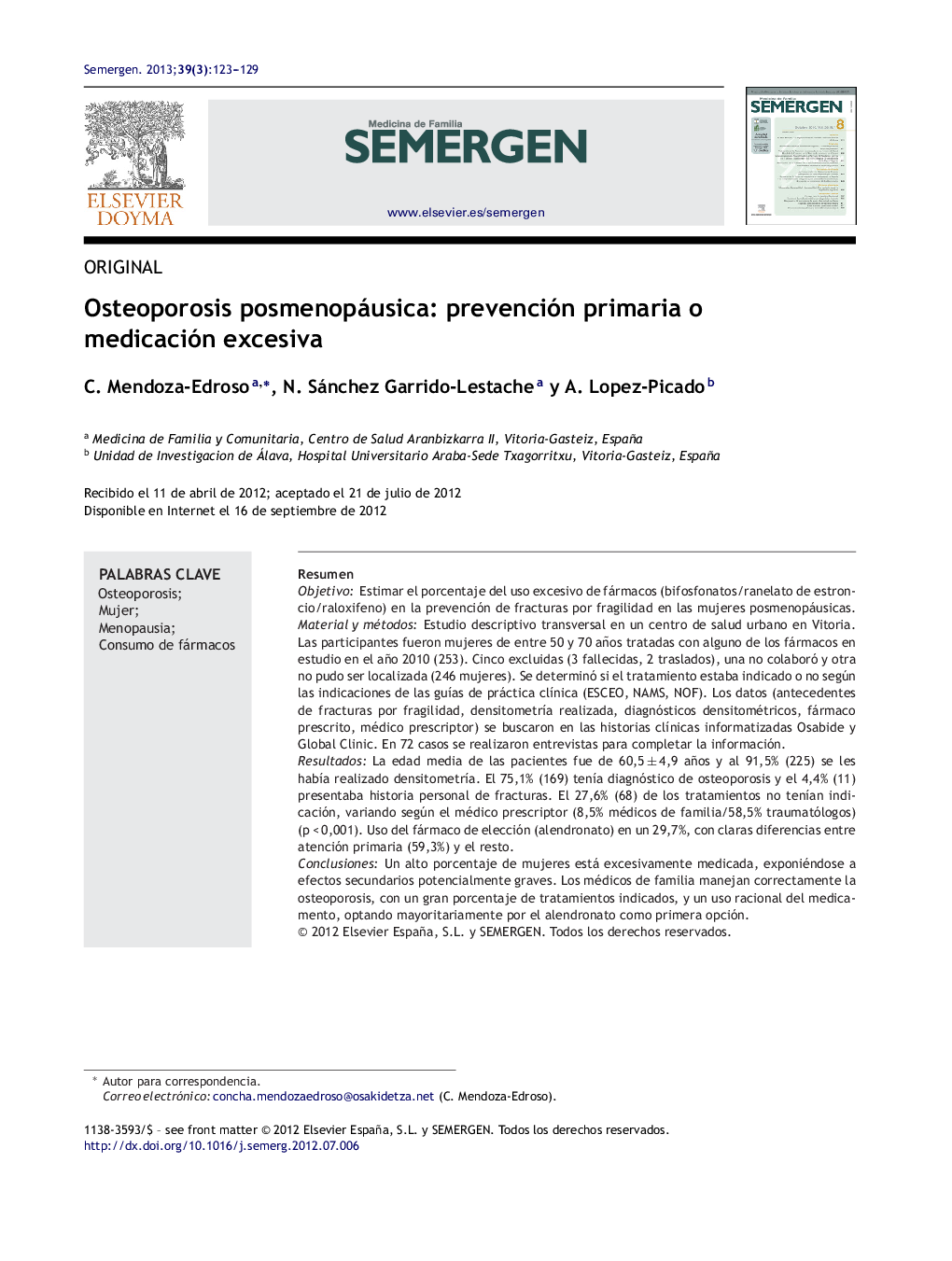| کد مقاله | کد نشریه | سال انتشار | مقاله انگلیسی | نسخه تمام متن |
|---|---|---|---|---|
| 3835113 | 1247355 | 2013 | 7 صفحه PDF | دانلود رایگان |

ResumenObjetivoEstimar el porcentaje del uso excesivo de fármacos (bifosfonatos/ranelato de estroncio/raloxifeno) en la prevención de fracturas por fragilidad en las mujeres posmenopáusicas.Material y métodosEstudio descriptivo transversal en un centro de salud urbano en Vitoria. Las participantes fueron mujeres de entre 50 y 70 años tratadas con alguno de los fármacos en estudio en el año 2010 (253). Cinco excluidas (3 fallecidas, 2 traslados), una no colaboró y otra no pudo ser localizada (246 mujeres). Se determinó si el tratamiento estaba indicado o no según las indicaciones de las guías de práctica clínica (ESCEO, NAMS, NOF). Los datos (antecedentes de fracturas por fragilidad, densitometría realizada, diagnósticos densitométricos, fármaco prescrito, médico prescriptor) se buscaron en las historias clínicas informatizadas Osabide y Global Clinic. En 72 casos se realizaron entrevistas para completar la información.ResultadosLa edad media de las pacientes fue de 60,5 ± 4,9 años y al 91,5% (225) se les había realizado densitometría. El 75,1% (169) tenía diagnóstico de osteoporosis y el 4,4% (11) presentaba historia personal de fracturas. El 27,6% (68) de los tratamientos no tenían indicación, variando según el médico prescriptor (8,5% médicos de familia/58,5% traumatólogos) (p < 0,001). Uso del fármaco de elección (alendronato) en un 29,7%, con claras diferencias entre atención primaria (59,3%) y el resto.ConclusionesUn alto porcentaje de mujeres está excesivamente medicada, exponiéndose a efectos secundarios potencialmente graves. Los médicos de familia manejan correctamente la osteoporosis, con un gran porcentaje de tratamientos indicados, y un uso racional del medicamento, optando mayoritariamente por el alendronato como primera opción.
ObjetiveEstimate the percentage of excessive use of medicines (bisphosponates, strontium ranelate and raloxifene) in the prevention of fragility fractures in postmenopausal women.Material and methodsA descriptive study conducted in an urban health centre in Vitoria-Gasteiz. The participants were women aged between 50 and 70, treated during 2010 with some of aforementioned medicines. Out of the 253 women included, three died, two moved, one did not want to sake part, and another one could not be found, leaving 246 participants. It was determinated if the treatment was or not indicated, as recommended in the ESCEO, NAMS and NOF clinical practice guides. A data search, including fragility fracture history, densitometry performed, densitometry diagnoses, prescribed medicines and prescribing doctor, was carried out by looking in the Osabide and Global Clinic digital clinic records. Interviews were carried out with 72 patients for a more complete information.ResultsThe mean patient age was 60.5 ± 4.9 years, and 91,5% of them (225) had undergone a densitometry. Three-quarters (75.1%, 169) had a diagnosis of osteoporosis and 4,4% (11) had previous history of fractures. More than a quarter (27.0%, 68) of treatments had no indication, and varied depending of the prescribing doctor (family doctors: 8.5%/ traumatologists: 58.5%) (p<0.001). The use of the medicine of choice, alendronate in 29.7% of cases, Was significantly higher (59.3%) in Primary Care than in other specialties.ConclusionsA high percentage of women are given excessive medication, exposing them to potentially severe secondary damages. Family doctors deal correctly with osteoporosis, with a high percentage of indicated treatments and a rational use of medicines, with alendronate as the first choice in the majority of cases.
Journal: SEMERGEN - Medicina de Familia - Volume 39, Issue 3, April 2013, Pages 123–129